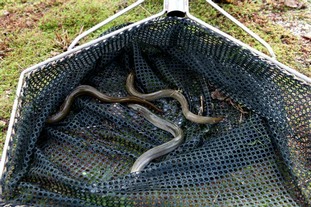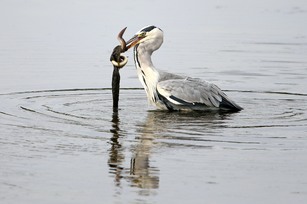

Biodiversity
Action
Plan
Eels are present in local rivers, playing a major part in aquatic ecosystems, both as predators and prey species. Bittern, herons and cormorants, all have Eels as prey as do Otters.
Locally Eel populations have benefited from wetlands creation and management and by the release of elvers. The removal of weirs and introduction of Eel passes will also help over time.
A snake-shaped fish, Eels can live in our freshwater rivers and standing water for over twenty years before migrating downstream to the sea, sometimes crossing wet grassland, to begin their journey to the area of the mid-Atlantic near North America called the Sargasso Sea to spawn.
The adults never return but the larvae drift on ocean currents to the coasts of the UK where they grow into ‘glass eels’.
Taking on a darker colour, as ‘elvers’ they enter estuaries and follow rivers upstream to mature where they can grow up to a metre in length. They can travel up drainage channels and over wet grass during the night.
In 2010 and during the period of the NIA, elvers were released at RSPB Old Moor in some numbers, swelling the local Eel population.
There have been considerable declines in Eel numbers and in the water bodies with Eel populations. Since the 1970s, the numbers of eels reaching Europe is thought to have declined by around 90%. Blocking of passage by weirs etc, floodplain cultivation and development, and loss of freshwater habitat, as well as disease and parasites, pollution and over-fishing, are all likely contributing factors to the species decline in England. Climate change and possible alterations in oceanic flow patterns may also have a role.
For further information on distribution, conservation and actions relating to Eel and other local priority fish species follow the links below.
European eel, Anguilla anguilla
UKBAP priority species
NERC Act Section 41 Species of Principal Importance
National priority species in Biodiversity 2020
Eel is a Local Priority Species because of its national status and the potential for its conservation in Barnsley.
European regulations required Eel management plans to be put in place to reverse the population decline.
The Eels (England and Wales) Regulations 2009 permit the Environment Agency to require an Eel pass at locations where the passage of eels is impeded or likely to be impeded.
Eels are protected by UK and international legislation including listing as endangered by the Convention on International Trade in Endangered Species (CITES) and as critically endangered on the IUCN Red List.
Associated Habitats
- Running water: rivers & streams
- Standing open water and canals
- Reedbeds


Eels. Old Moor. Matthew Capper
Eel and Heron. Old Moor. Mary Wilde
Eel